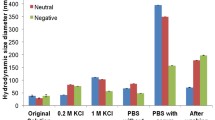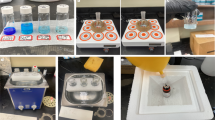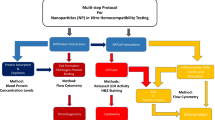Abstract
The biocompatibility of NPs to blood cells is a key issue when these NPs are planned for intravenous application because of potential contact with blood cells and proteins. In this work, γ-Fe2O3 NPs (~ 9 nm) and their poly(N,N-dimethylacrylamide) (PDMA) and SiO2-coated derivatives (γ-Fe2O3@PDMA and γ-Fe2O3@SiO2, respectively) were investigated. It was detected that both PDMA and SiO2 coatings decreased NPs’ aggregation in the buffer solutions, as well as in cell culture medium. Neither neat γ-Fe2O3 NPs nor their coated derivatives possessed hemolytic activity toward red blood cells. There was no significant loss of body weight observed after the intravenous injection to laboratory mice. The immune response to the injected NPs was assessed by the ELISA measuring. No antibodies of the IgM class were detected, which suggests lack of acute inflammation. On the 35th day of the experiment, there was a rise in the content of the anti-OVA IgG noticed in all three types of the NPs; however, this rise was lower compared to that induced by the positive control. The injected NPs were found to be spread and settled in the pouch cavity, and none of the tested NPs caused vascular damage or distinct signs of inflammation. Summarizing, γ-Fe2O3 NPs coated with the PDMA or SiO2 manifested good compatibility with blood cells in in vitro and in vivo investigations.









Similar content being viewed by others
Data availability
Not applicable.
References
Abdelhalim MAK, Abdelmottaleb Moussa SA (2013) The gold nanoparticle size and exposure duration effect on the liver and kidney function of rats: In vivo. Saudi J Biol Sci 20:177–181. https://doi.org/10.1016/j.sjbs.2013.01.007
Al-Deen F, Xiang S, Ma C et al (2017) Magnetic nanovectors for the development of DNA blood-stage malaria vaccines. Nanomaterials 7:30. https://doi.org/10.3390/nano7020030
Alle M, Reddy GB, Kim TH et al (2020) Doxorubicin-carboxymethyl xanthan gum capped gold nanoparticles: Microwave synthesis, characterization, and anti-cancer activity. Carbohydr Polym 229:115511. https://doi.org/10.1016/j.carbpol.2019.115511
Asharani PV, Sethu S, Vadukumpully S et al (2010) Investigations on the structural damage in human erythrocytes exposed to silver, gold, and platinum nanoparticles. Adv Funct Mater 20:1233–1242. https://doi.org/10.1002/adfm.200901846
Bilyy R, Unterweger H, Weigel B et al (2018) Inert coats of magnetic nanoparticles prevent formation of occlusive intravascular co-aggregates with neutrophil extracellular traps. Front Immunol 9:2266. https://doi.org/10.3389/fimmu.2018.02266
Blanco E, Shen H, Ferrari M (2015) Principles of nanoparticle design for overcoming biological barriers to drug delivery. Nat Biotechnol 33:941–951. https://doi.org/10.1038/nbt.3330
Boraschi D, Italiani P, Palomba R et al (2017) Nanoparticles and innate immunity: new perspectives on host defence. Semin Immunol 34:33–51. https://doi.org/10.1016/j.smim.2017.08.013
Bostan HB, Rezaee R, Valokala MG et al (2016) Cardiotoxicity of nano-particles. Life Sci 165:91–99. https://doi.org/10.1016/j.lfs.2016.09.017
Böyum A (1968) Isolation of mononuclear cells and granulocytes from human blood. Isolation of mononuclear cells by one centrifugation, and of granulocytes by combining centrifugation and sedimentation at 1 g. Scand J Clin Lab Invest Suppl 97:77–89
Cho W-S, Duffin R, Poland CA et al (2010) Metal oxide nanoparticles induce unique inflammatory footprints in the lung: important implications for nanoparticle testing. Environ Health Perspect 118:1699–1706. https://doi.org/10.1289/ehp.1002201
De Gregorio E, Caproni E, Ulmer JB (2013) Vaccine adjuvants: mode of action. Front Immunol 4:214. https://doi.org/10.3389/fimmu.2013.00214
de la Harpe K, Kondiah P, Choonara Y et al (2019) The hemocompatibility of nanoparticles: a review of cell-nanoparticle interactions and hemostasis. Cells 8:1209. https://doi.org/10.3390/cells8101209
Dobrovolskaia MA, Clogston JD, Neun BW et al (2008) Method for analysis of nanoparticle hemolytic properties in vitro. Nano Lett 8:2180–2187. https://doi.org/10.1021/nl0805615
Dutch Boltz RC, Fischer PA, Wicker LS, Peterson LB (1994) Single UV excitation of hoechst 33342 and ethidium bromide for simultaneous cell cycle analysis and viability determinations on in vitro cultures of murine B lymphocytes. Cytometry 15:28–34. https://doi.org/10.1002/cyto.990150106
El-Sayed A, Kamel M (2020) Advances in nanomedical applications: diagnostic, therapeutic, immunization, and vaccine production. Environ Sci Pollut Res 27:19200–19213. https://doi.org/10.1007/s11356-019-06459-2
Evani SJ, Ramasubramanian A (2011) Hemocompatibility of nanoparticles. In: Nanobiomaterials Handbook. pp 1–17
Farhana A, Lappin S (2022) Biochemistry, lactate dehydrogenase. StatPearls [Internet]. Treasure Island (FL): StatPearls Publishing. PMID: 32491468
Feng Q, Liu Y, Huang J et al (2018) Uptake, distribution, clearance, and toxicity of iron oxide nanoparticles with different sizes and coatings. Sci Rep 8:2082. https://doi.org/10.1038/s41598-018-19628-z
Ferrari R, Sponchioni M, Morbidelli M, Moscatelli D (2018) Polymer nanoparticles for the intravenous delivery of anticancer drugs: the checkpoints on the road from the synthesis to clinical translation. Nanoscale 10:22701–22719. https://doi.org/10.1039/C8NR05933K
Georgieva JV, Kalicharan D, Couraud P-O et al (2011) Surface characteristics of nanoparticles determine their intracellular fate in and processing by human blood-brain barrier endothelial cells in vitro. Mol Ther 19:318–325. https://doi.org/10.1038/mt.2010.236
Hajshafiei P, Fatahian S (2016) The effect of BSA and DMSA coated iron oxide nanoparticles on liver and renal function in mice. West Indian Med J 65:474–479. https://doi.org/10.7727/wimj.2014.035
Herrmann IK, Urner M, Hasler M et al (2011) Iron core/shell nanoparticles as magnetic drug carriers: possible interactions with the vascular compartment. Nanomedicine 6:1199–1213. https://doi.org/10.2217/nnm.11.33
Huemer HP (2015) Possible immunosuppressive effects of drug exposure and environmental and nutritional effects on infection and vaccination. Mediators Inflamm 2015:1–7. https://doi.org/10.1155/2015/349176
Jiang Y, Li Y, Richard C et al (2019) Hemocompatibility investigation and improvement of near-infrared persistent luminescent nanoparticle ZnGa2O4:Cr3+ by surface PEGylation. J Mater Chem B 7:3796–3803. https://doi.org/10.1039/C9TB00378A
Kim MJ, Shin S (2014) Toxic effects of silver nanoparticles and nanowires on erythrocyte rheology. Food Chem Toxicol 67:80–86. https://doi.org/10.1016/j.fct.2014.02.006
Kong N, Jiang T, Zhou Z, Fu J (2009) Cytotoxicity of polymerized resin cements on human dental pulp cells in vitro. Dent Mater 25:1371–1375. https://doi.org/10.1016/j.dental.2009.06.008
Kou L, Bhutia YD, Yao Q et al (2018) Transporter-guided delivery of nanoparticles to improve drug permeation across cellular barriers and drug exposure to selective cell types. Front Pharmacol 9:27. https://doi.org/10.3389/fphar.2018.00027
Lasagna-Reeves C, Gonzalez-Romero D, Barria MA et al (2010) Bioaccumulation and toxicity of gold nanoparticles after repeated administration in mice. Biochem Biophys Res Commun 393:649–655. https://doi.org/10.1016/j.bbrc.2010.02.046
Lee N-Y, Ko W-C, Hsueh P-R (2019) Nanoparticles in the treatment of infections caused by multidrug-resistant organisms. Front Pharmacol 10:1153. https://doi.org/10.3389/fphar.2019.01153
Mankamna Kumari R, Goswami R, Nimesh S (2020) Application of nanotechnology in diagnosis and therapeutics. In: Ledwani L, Sangwai JS (eds) Nanotechnology for energy and environmental engineering. Springer International Publishing, Cham, pp 413–440
Manshian BB, Poelmans J, Saini S et al (2018) Nanoparticle-induced inflammation can increase tumor malignancy. Acta Biomater 68:99–112. https://doi.org/10.1016/j.actbio.2017.12.020
Maueröder C, Mahajan A, Paulus S et al (2016) Ménage-à-Trois: the ratio of bicarbonate to CO2 and the pH regulate the capacity of neutrophils to form NETs. Front Immunol 7:583. https://doi.org/10.3389/fimmu.2016.00583
Mitchell MJ, Billingsley MM, Haley RM et al (2021) Engineering precision nanoparticles for drug delivery. Nat Rev Drug Discov 20:101–124. https://doi.org/10.1038/s41573-020-0090-8
Muñoz L, Bilyy R, Biermann MC et al (2016) Nanoparticles size-dependently initiate self-limiting NETosis-driven inflammation. Proc Natl Acad Sci 113:E5856–E5865. https://doi.org/10.1073/pnas.1602230113
Mushtaq S, Shahzad K, Saeed T et al (2021) Biocompatibility and cytotoxicity in vitro of surface-functionalized drug-loaded spinel ferrite nanoparticles. Beilstein J Nanotechnol 12:1339–1364. https://doi.org/10.3762/bjnano.12.99
Nygaard UC, Hansen JS, Samuelsen M et al (2009) Single-walled and multi-walled carbon nanotubes promote allergic immune responses in mice. Toxicol Sci 109:113–123. https://doi.org/10.1093/toxsci/kfp057
Parasuraman S, Raveendran R, Kesavan R (2010) Blood sample collection in small laboratory animals. J Pharmacol Pharmacother 1:87. https://doi.org/10.4103/0976-500X.72350
Parhiz H, Khoshnejad M, Myerson JW et al (2018) Unintended effects of drug carriers: Big issues of small particles. Adv Drug Deliv Rev 130:90–112. https://doi.org/10.1016/j.addr.2018.06.023
Paryzhak S, Dumych T, Bila G, Bilyy R (2019) Application of air pouch model for evaluation the ability of immune cells to sequester foreign nano- and microparticles. Exp Clin Physiol Biochem 85(1):52–57. https://doi.org/10.25040/ecpb2019.01.052
Paryzhak SY, Dumych TI, Klyuchivska OY et al (2022) Silver doping of clinoptilolite particles enhances their effects on immunocompetent mammalian cells and inhibition of Candida albicans fungi. Appl Nanosci. https://doi.org/10.1007/s13204-022-02624-1
Pati R, Shevtsov M, Sonawane A (2018) Nanoparticle vaccines against infectious diseases. Front Immunol 9:2224. https://doi.org/10.3389/fimmu.2018.02224
Pramanik P, Krishnan P, Maity A et al (2020) Application of nanotechnology in agriculture. In: Dasgupta N, Ranjan S, Lichtfouse E (eds) Environmental Nanotechnology, vol 4. Springer International Publishing, Cham, pp 317–348
Prasad R, Bhattacharyya A, Nguyen QD (2017) Nanotechnology in sustainable agriculture: recent developments, challenges, and perspectives. Front Microbiol 8:1014. https://doi.org/10.3389/fmicb.2017.01014
Radko L, Stypuła-Trębas S, Posyniak A et al (2019) Silver(I) complexes of the pharmaceutical agents metronidazole and 4-hydroxymethylpyridine: comparison of cytotoxic profile for potential clinical application. Molecules 24:1949. https://doi.org/10.3390/molecules24101949
Ritz S, Schöttler S, Kotman N et al (2015) Protein corona of nanoparticles: distinct proteins regulate the cellular uptake. Biomacromol 16:1311–1321. https://doi.org/10.1021/acs.biomac.5b00108
Sanità G, Carrese B, Lamberti A (2020) Nanoparticle surface functionalization: how to improve biocompatibility and cellular internalization. Front Mol Biosci 7:587012. https://doi.org/10.3389/fmolb.2020.587012
Santos EW, de Oliveira DC, Hastreiter A et al (2016) Hematological and biochemical reference values for C57BL/6, Swiss Webster and BALB/c mice. Brazilian J Vet Res Anim Sci 53:138. https://doi.org/10.11606/issn.1678-4456.v53i2p138-145
Sheth SG, Flamm SL, Gordon FD, Chopra S (1998) AST/ALT ratio predicts cirrhosis in patients with chronic hepatitis C virus infection. Am J Gastroenterol 93:44–48. https://doi.org/10.1111/j.1572-0241.1998.044_c.x
Shvedova AA, Tkach AV, Kisin ER et al (2013) Carbon nanotubes enhance metastatic growth of lung carcinoma via up-regulation of myeloid-derived suppressor cells. Small 9:1691–1695. https://doi.org/10.1002/smll.201201470
Sin YM, Sedgwick AD, Chea EP, Willoughby DA (1986) Mast cells in newly formed lining tissue during acute inflammation: a six day air pouch model in the mouse. Ann Rheum Dis 45:873–877. https://doi.org/10.1136/ard.45.10.873
Singh T, Shukla S, Kumar P et al (2017) Application of nanotechnology in food science: perception and overview. Front Microbiol 8:1501. https://doi.org/10.3389/fmicb.2017.01501
Stahl FR, Jung R, Jazbutyte V et al (2018) Laboratory diagnostics of murine blood for detection of mouse cytomegalovirus (MCMV)-induced hepatitis. Sci Rep 8:14823. https://doi.org/10.1038/s41598-018-33167-7
Stark WJ, Stoessel PR, Wohlleben W, Hafner A (2015) Industrial applications of nanoparticles. Chem Soc Rev 44:5793–5805. https://doi.org/10.1039/C4CS00362D
Stöber W, Fink A, Bohn E (1968) Controlled growth of monodisperse silica spheres in the micron size range. J Colloid Interface Sci 26:62–69. https://doi.org/10.1016/0021-9797(68)90272-5
Suresh VSR (2021) Recent advances on renal toxicity of engineered nanoparticles – a review. J Toxicol Risk Assess. https://doi.org/10.23937/2572-4061.1510036
Tate JA, Ogden JA, Strawbridge RR, et al (2009) Toxicity and biodistribution of activated and non-activated intravenous iron oxide nanoparticles. In: Ryan TP (ed). p 71810L
Toyama T, Matsuda H, Ishida I et al (2008) A case of toxic epidermal necrolysis-like dermatitis evolving from contact dermatitis of the hands associated with exposure to dendrimers. Contact Dermatitis 59:122–123. https://doi.org/10.1111/j.1600-0536.2008.01340.x
Webster TJ, Seil I (2012) Antimicrobial applications of nanotechnology: methods and literature. Int J Nanomedicine 7:2767–2781. https://doi.org/10.2147/IJN.S24805
Yao Y, Wei Y, Chen S (2015) Size effect of the surface energy density of nanoparticles. Surf Sci 636:19–24. https://doi.org/10.1016/j.susc.2015.01.016
Zasońska BA, Boiko N, Horák D et al (2013) The use of hydrophilic poly(N, N-dimethylacrylamide) for promoting engulfment of magnetic γ-Fe2O3 nanoparticles by mammalian cells. J Biomed Nanotechnol 9:479–491. https://doi.org/10.1166/jbn.2013.1552
Zhu M, Tian X, Song X et al (2012) Nanoparticle-induced exosomes target antigen-presenting cells to initiate Th1-type immune activation. Small 8:2841–2848. https://doi.org/10.1002/smll.201200381
Acknowledgements
The authors are very grateful to the Czech Science Foundation (No. 20-02177J) for constant support. We highly appreciate the help from Cedars-Sinai Medical Center’s International Research and Innovation in Medicine Program, and the Association for Regional Cooperation in the Fields of Health, Science and Technology (RECOOP HST Association). Dr. Volodymyr Hrenyukh (Ivan Franko National University of Lviv, Ukraine) is acknowledged for conducting computer analysis of NETs images for their numerical estimation.
Author information
Authors and Affiliations
Corresponding author
Ethics declarations
Conflict of interest
No conflict of interests is declared by the corresponding authors.
Additional information
Publisher's Note
Springer Nature remains neutral with regard to jurisdictional claims in published maps and institutional affiliations.
Rights and permissions
Springer Nature or its licensor (e.g. a society or other partner) holds exclusive rights to this article under a publishing agreement with the author(s) or other rightsholder(s); author self-archiving of the accepted manuscript version of this article is solely governed by the terms of such publishing agreement and applicable law.
About this article
Cite this article
Paryzhak, S., Dumych, T., Zasońska, B. et al. Improvement of hemocompatibility of γ-Fe2O3 nanoparticles via their covering with complex poly(N,N-dimethylacrylamide) and SiO2 shell. Appl Nanosci 13, 7399–7412 (2023). https://doi.org/10.1007/s13204-023-02905-3
Received:
Accepted:
Published:
Issue Date:
DOI: https://doi.org/10.1007/s13204-023-02905-3




